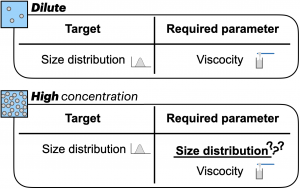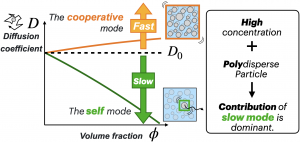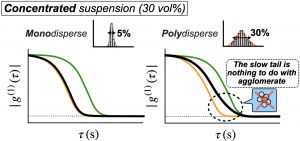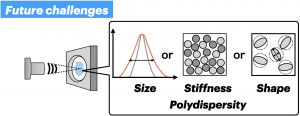Original article: Particle Sizing in Highly Concentrated Polydisperse Particle Suspensions by Dynamic Ultrasound Scattering
On August 26, 2025, a paper on a new particle sizing method using ultrasound was published in Elsevier’s journal, Colloids Surf. A Physicochem. Eng. Asp.
Background
Evaluating particle size distribution—one of the most important parameters in controlling the functionality of microparticles-as-is, without dilution or drying, is a considerable challenge both in academic research and industrial applications. For instance, when a sample containing aggregates that significantly impair product performance is diluted for analysis, such small aggregates become diluted as well, making it difficult to detect the problems. Furthermore, weak aggregates may easily break apart during dilution or drying.

For academic science, high concentration samples (so-called concentrated systems) are complex systems involving both short-range and long-range many-body interactions. Understanding the dynamic properties associated with these interactions—particularly those involving moving particles—remains a challenging task in colloid science.

Challenges
Well, as is well known from fetal ultrasound diagnostics, ultrasound has the advantage that it can be applied even to samples that do not transmit light. However, the ability of the beam to transmit is not sufficient to understand the interactions acting between particles, nor the fundamental causes of the resulting macroscopic viscous resistance and microscopic structure formation. Therefore, the development of quantitative techniques that incorporate particle interactions through dynamic analysis of concentrated systems becomes crucial.

In fact, if you search for “ultrasonic method,” you’ll find that techniques examining frequency spectra, such as ultrasonic attenuation methods and ultrasonic spectroscopy, are generally available. While this method can be somewhat useful for highly concentrated emulsions, it faces significant challenges with solid particles and nanoparticles. For example, a major issue was the large number of parameters that must be known beforehand for both the particles and the solvent, such as density, sound velocity, viscosity, specific heat, coefficient of thermal expansion, and thermal conductivity.

In the field of optics, people may use dynamic light scattering (DLS). This method is extremely simple, requiring only the solvent viscosity as a parameter to be known in advance. While the sample must be very dilute to allow light transmission, its advantage is that particle size distribution can be easily obtained without prior information.

Novelty
Dynamic ultra(Sound) Scattering (DSS) is exactly the technique that achieves this DLS using only ultrasound. However, until now, it was considered impossible to determine particle size under high-concentration conditions for samples with a broad particle size distribution. The reason is that the contributions of the cooperative mode, which detects the relationship between multiple particles, and the self-mode, which represents the individual motion of particles—both discussed in this paper—depend on the particle size distribution. In other words, while determining the particle size distribution of an unknown sample was the goal, the size distribution had to be known to conduct the analysis. This paper resolves this contradiction by developing a new method that calculates the unknown particle size distribution, taking into account both the cooperative diffusion mode and the self-diffusion mode.


Cooperative mode is a fast diffusion mode, while self-diffusion mode is a slow diffusion mode. In other words, this predicts for a sample with a broad particle size distribution at high concentration, a slow relaxation mode not observed in monodisperse or dilute systems will be experimentally detected. When slow modes are observed, even in historical papers, it is often mistaken to interpret them straightforwardly for the formation of aggregates. However, this is often a serious misunderstanding. Slow relaxation modes can appear even when the particles are dispersed very well (without the presence of aggregates).



In this study, we directly captured nanoparticles moving in real time using ultrasound and accurately measured the average particle size and polydispersity for both monodisperse samples (polydispersity of about 5%) and polydisperse samples (polydispersity of about 24%) at a high concentration of 30 vol%. This represents a significant challenge even for DLS instruments capable of high-concentration measurements, making it the first dynamic ultrasound analysis to be successfully achieved globally.

Future Challenges
Research on dynamic scattering for these polydisperse samples has just begun. Practical materials are likely to exhibit even greater complexity. Examples include samples with higher size polydispersity, samples exhibiting polydispersity not only in size but also in stiffness (material properties), and samples with shape polydispersity. Since the contrast of ultrasound is based on stiffness, various studies can be performed. These are just the research topics for the future.

